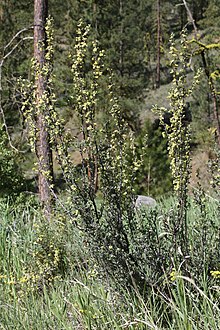| Bitterbrush | |
|---|---|

| |
| Purshia tridentata, Wenas Wildlife Area | |
| Scientific classification | |
| Kingdom: | Plantae |
| Clade: | Tracheophytes |
| Clade: | Angiosperms |
| Clade: | Eudicots |
| Clade: | Rosids |
| Order: | Rosales |
| Family: | Rosaceae |
| Genus: | Purshia |
| Species: | P. tridentata
|
| Binomial name | |
| Purshia tridentata | |
| Synonyms[1] | |
| |
Purshia tridentata, with the common name bitterbrush,[1][2][3] is a shrub in the genus Purshia of the family Rosaceae. It is native to mountainous areas of western North America.[3]
Common names include antelope bitterbrush,[3][2] antelope bush,[2] buckbrush, quinine brush, and less commonly deerbrush, blackbrush, and greasewood.[4] Some of these names are shared with other species.
Description
[edit]Purshia tridentata is a deciduous shrub growing to a height of 1–5 metres (3+1⁄2–16+1⁄2 feet). It has many branches and slender green,[5] three- to five-lobed leaves 5–20 millimetres long. It is a nitrogen-fixing plant.[6]
The flowers are pale yellow,[5] with five petals 6–8 mm long, and darker yellow anthers. The fruit is a cluster of dry, slender, leathery achenes 0.6–2 centimetres long.
Varieties
[edit]There are two named varieties of the species:
- Purshia tridentata var. glandulosa — Eastern Sierra Nevada, Southern California[7]
- Purshia tridentata var. tridentata[8]
Distribution
[edit]The plant is found from southeastern British Columbia in the north, east to Montana and Wyoming, south to New Mexico, and west in California.[3] It grows on arid mountainsides and slopes, as well as rocky or drained soils with somewhat more moisture than the sagebrush steppe.[5] It is often associated with Balsamorhiza as well as Wyethia species, and in southern areas hybridizes with Purshia stansburyana.[5]
In California it occurs between 700–3,400 m (2,300–11,200 ft) above sea level, including in the Peninsular Ranges, Transverse Ranges, and Sierra Nevada, and southern Cascade Range.[2][9] Further north it occurs at lower elevations, such as at 320–1,065 m (1,050–3,494 ft) in British Columbia.[10]
Uses
[edit]The shrub is an important forage plant for many game animals, including deer,[5] especially during the winter.[11]
References
[edit]- ^ a b James Henrickson, "Purshia tridentata (Pursh) de Candolle, Trans. Linn. Soc. London. 12: 158. 1818", Flora of North America, vol. 9
- ^ a b c d CalFlora Database:Purshia tridentata . accessed 9.22.2013
- ^ a b c d USDA, NRCS (n.d.). "Purshia tridentata". The PLANTS Database (plants.usda.gov). Greensboro, North Carolina: National Plant Data Team. Retrieved 16 October 2015.
- ^ United States Congressional serial set. U.S. Government Printing Office. 1861.
- ^ a b c d e Taylor, Ronald J. (1994) [1992]. Sagebrush Country: A Wildflower Sanctuary (rev. ed.). Missoula, MT: Mountain Press Pub. Co. p. 126. ISBN 0-87842-280-3. OCLC 25708726.
- ^ David Andrews Dalton (1975). Nitrogen fixation by Purshia tridentata: some ecological aspects and root nodule anatomy. Oregon State University. Retrieved 16 November 2011.
- ^ CalFlora Database: Purshia tridentata var. glandulosa
- ^ CalFlora Database: Purshia tridentata var. tridentata
- ^ Brian Vanden Heuvel & Thomas J. Rosatti 2016. Purshia tridentata, in Jepson Flora Project (eds.) Jepson eFlora, accessed 19 June 2016
- ^ E-FLORA BC: Electronic Atlas of the Flora of British Columbia
- ^ Whitney, Stephen (1985). Western Forests (The Audubon Society Nature Guides). New York: Knopf. p. 401. ISBN 0-394-73127-1.
External links
[edit]- Central Washington Native Plants: Antelope bitterbrush
- Range Plants of Utah: Purshia tridentata (Antelope bitterbrush)
 Media related to Purshia tridentata at Wikimedia Commons
Media related to Purshia tridentata at Wikimedia Commons


Well, that’s interesting to know that Psilotum nudum are known as whisk ferns. Psilotum nudum is the commoner species of the two. While the P. flaccidum is a rare species and is found in the tropical islands. Both the species are usually epiphytic in habit and grow upon tree ferns. These species may also be terrestrial and grow in humus or in the crevices of the rocks.
View the detailed Guide of Psilotum nudum: Detailed Study Of Psilotum Nudum (Whisk Fern), Classification, Anatomy, Reproduction